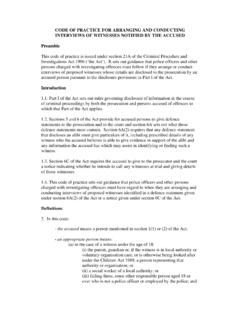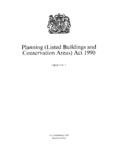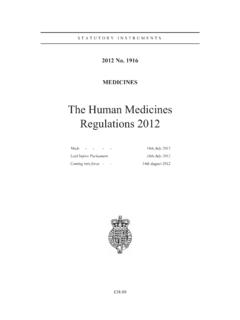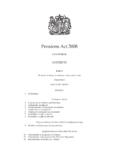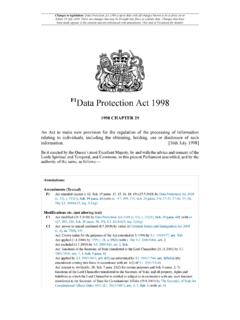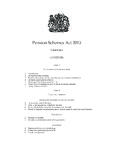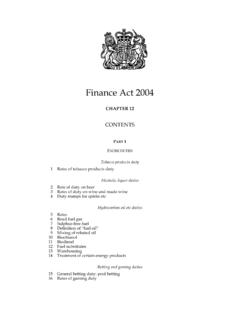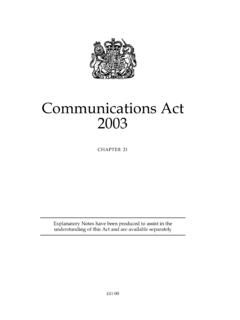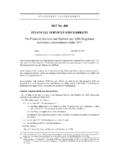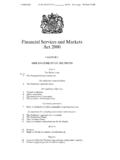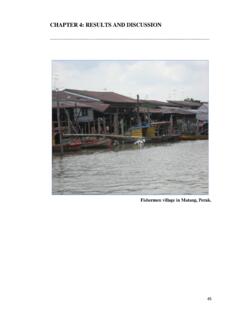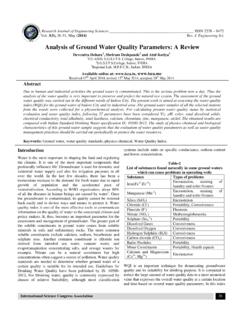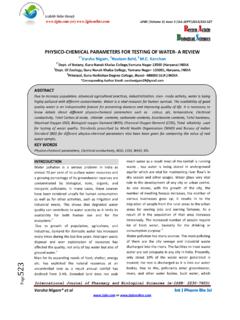Transcription of The Water Framework Directive (Standards and ...
1 The Water Framework Directive (Standards and Classification) Directions (England and Wales) 2015 CONTENTS 1. Citation, commencement and application 2 2. Interpretation 2 3. 4. Directions for the classification of surface Water and groundwater bodies 4 5. Reviewing the classifications 4 6. Monitoring 4 7. 10. Standards for surface Water bodies 5 11. groundwater bodies 5 12. Further directions about priority substances 5 13. Solway Tweed river basin district 6 14. Revocations 6 SCHEDULE 1 Classification of status of surface Water bodies 7 PART 1 Determining the ecological status of a body of surface Water (other than one designated as artificial or heavily modified) 7 PART 2 Determining the ecological potential of a body of surface Water designated as being artificial or heavily modified 8 PART 3 Determining the chemical status of a body of surface Water 9 PART 4 Determining high status for hydromorphological quality elements in a Water body 10 SCHEDULE 2 Categorisation of surface Water body types 14 SCHEDULE 3 Standards for ecological and chemical status of surface waters 17 PART 1 physico - chemical standards 17 PART 2 Specific pollutants 25 PART 3 Priority substances 28 PART 4 Biological element status boundary values 38 SCHEDULE 4 Classification of status of groundwater bodies 46 PART 1 Classifying the chemical status of groundwater 46 PART 2 Classifying the quantitative status of groundwater 48 SCHEDULE 5 Threshold Values for groundwater 50 SCHEDULE 6 Specified lakes 52 The Secretary of State, in exercise of the powers conferred by section 40(2)
2 Of the Environment Act 1995(a), and having consulted the Welsh Ministers to the extent that there is any effect in those parts of Wales that are within the catchment areas of the rivers Dee, Wye and Severn, and having also consulted the Environment Agency, gives the following Directions to the Environment Agency. (a) 1995 ; section 40(2) was amended by 2011/1043. 2 The Welsh Ministers, in exercise of the powers conferred by article 11 of the Natural Resources Body for Wales (Establishment) Order 2012(a), and having consulted the Secretary of State to the extent that there is any effect in those parts of England that are within the catchment areas of the rivers Dee, Wye and Severn, and having also consulted the Natural Resources Body for Wales, give the following Directions to the Natural Resources Body for Wales.
3 The Directions are given for the implementation of: (a) Directive 2000/60/EC of the European Parliament and of the Council establishing a Framework for Community action in the field of Water policy(b); (b) Directive 2008/105/EC of the European Parliament and of the Council on environmental quality standards in the field of Water policy(c); (c) Directive 2013/39/EU of the European Parliament and of the Council amending Directives 2000/60/EC and 2008/105/EC as regards priority substances in the field of Water policy(d). Citation, commencement and application 1. (1) These Directions may be cited as the Water Framework Directive (Standards and Classification) Directions (England and Wales) 2015. (2) The following provisions come into force on 14th September 2015 (a) this article and article 2; (b) article 12(a) and (b); (c) paragraphs 9 to 11 and 18 to 20 of Part 3 of Schedule 3; and (d) Table 1 in Part 3 of Schedule 3. (3) The remainder of these Directions come into force on 22nd December 2015.
4 (4) These Directions apply in relation to bodies of surface Water and groundwater in England and Wales. Interpretation 2. (1) In these Directions the EQS Directive means Directive 2008/105/EC of the European Parliament and of the Council on environmental quality standards in the field of Water policy; the groundwater Directive means Directive 2006/118/EC of the European Parliament and of the Council on the protection of groundwater against pollution and deterioration(e); the QAQC Directive means Directive 2009/90/EC on technical specifications for chemical analysis and monitoring of Water status(f); the Water Framework Directive means Directive 2000/60/EC of the European Parliament and of the Council of 23rd October 2000 establishing a Framework for Community action in the field of Water policy; the WFD Regulations means the Water Environment ( Water Framework Directive ) (England and Wales) Regulations 2003(g).
5 (a) 2012/1903, amended by 2013/755( ). (b) OJ No L 327, , p 1, as last amended by Directive 2014/101/EU (OJ No L 311, , p 32). (c) OJ No L 348, , , as last amended by Directive 2013/39/EU (OJ No L 226, , p1). (d) OJ No L 226, , p 1. (e) OJ No L 372, , p 19, as last amended by Directive 2014/80/EU (OJ No L 182, , p 52). (f) OJ No L 201, , p 36. (g) 2003/3242, as amended by 2005/2035, 2007/3538, 2008/1097, 2010/675, 2011/556, 603, 1043, 2013/755 ( ) and 1675. 3 5 percentile standard means a standard that is failed if the measured value of the parameter to which the standard refers is less than the standard for more than 5% of the time; 10 percentile standard means a standard that is failed if the measured value of the parameter to which the standard refers (for example the concentration of a pollutant) is less than the standard for more than 10% of the time; 90 percentile standard means a standard that is failed if the measured value of the parameter to which the standard refers (for example the concentration of a pollutant) is greater than the standard for 10% or more of the time; 95 percentile standard means a standard that is failed if the measured value of the parameter to which the standard refers (for example the concentration of a pollutant) is greater than the standard for 5% or more of the time.
6 98 percentile standard means a standard that is failed if the measured value of the parameter to which the standard refers (for example the concentration of a pollutant) is greater than the standard for 2% or more of the time; 99 percentile standard means a standard that is failed if the measured value of the parameter to which the standard refers (for example the concentration of a pollutant) is greater than the standard for 1% or more of the time; ambient river temperature means the temperature, in degrees centigrade, of a river or part of a river in the absence of any heat pollution or artificial release of Water affecting the temperature of that river or part; annual mean may relate to a period of 1 year, or a multiple of such period; the Appropriate Agency means the Environment Agency in relation to England and the Natural Resources Body for Wales in relation to Wales; biota taxon means a particular aquatic taxon within the taxonomic rank sub-phylum , class or their equivalent; compliance assessment period means the period over which measured values are obtained for the purposes of calculating an arithmetic average or a percentile value; this may be part of a year; a year; part of several years; or several years; cyprinid , in relation to a Water body means that, in the Appropriate Agency s judgement, the Water body would, in the absence of more than slight disturbances resulting from human activity, support a sustainable fish population dominated by cyprinid, but not salmonid species; good , when referring to the ecological status of a Water body, means the boundary between the conditions consistent with the description of good ecological status and moderate ecological status in accordance with section of Annex V to the Water Framework Directive .
7 Values on the boundary are consistent with the description of good status; good , when referring to priority substance environmental standards, means the boundary between conditions consistent with the description of good surface Water chemical status and failing to achieve good surface Water chemical status in Article 2 of, and Annex V to, the Water Framework Directive ; high , when referring to the ecological status of a Water body, means the boundary between the conditions consistent with the description of high ecological status and good ecological status in accordance with section of Annex V to, the Water Framework Directive ; values on the boundary are consistent with the description of high status; matrix means a compartment of the aquatic environment, namely Water , sediment or biota; moderate , when referring to the ecological status of a Water body, means the boundary between the conditions consistent with the description of moderate ecological status and poor ecological status, in accordance with section of Annex V to the Water Framework Directive ; values on the boundary are consistent with the description of moderate status; percentile standard means a standard for which the relevant value must be achieved for the specified percentage of the compliance assessment period; 4 poor when referring to the ecological status of a Water body, means the boundary between the conditions consistent with the description of poor ecological status and bad ecological status in accordance with section of Annex V to the Water Framework Directive ; values on the boundary are consistent with the description of poor status.
8 Programme of measures means a programme of measures required by Article 11 of the Water Framework Directive ; salinity means the ratio of the electrical conductivity of a sample of Water (at 15 C, and one standard atmospheric pressure) to that of a standard solution of Potassium Chloride (KCl); a ratio of 1 is equivalent to a salinity of 35; salmonid in relation to a Water body, means that, in the Appropriate Agency s judgement, the Water body would, in the absence of more than slight disturbances resulting from human activity, support a sustainable fish population dominated by salmonid species; specified lakes means the lakes listed in the table in Schedule 6; year means any 12 month period. (2) Any expression used in these Directions and the Water Framework Directive , the groundwater Directive , the QAQC Directive , or the WFD Regulations, and not otherwise defined in these Directions has the same meaning for the purposes of these Directions as it has for the purposes of the applicable Directive or the Regulations.
9 Directions for the classification of surface Water and groundwater bodies 3. The Appropriate Agency must classify (a) the ecological status of a body of surface Water (other than one designated as artificial or heavily modified) in accordance with Part 1 of Schedule 1; (b) the ecological potential of a body of surface Water designated as artificial or heavily modified in accordance with Part 2 of Schedule 1; (c) the chemical status of a body of surface Water in accordance with Part 3 of Schedule 1; and (d) the chemical and quantitative status of a body of groundwater in accordance with Schedules 4 and 5. 4. In performing its functions under article 3, the Appropriate Agency must (a) discount data influenced by a one-off or transient incident which, if used, would lead to an unrepresentative classification of a Water body s status; and (b) estimate the level of confidence and precision of the classification results, and report on this to the Secretary of State, or the Welsh Ministers, as appropriate.
10 Reviewing the classifications 5. The Appropriate Agency must, as applicable and at least once every 6 years, review and update the classification of Water bodies as new data are collected through its monitoring programmes, and if appropriate from other sources, in accordance with article 8 and Annex 5 of the Water Framework Directive . Monitoring 6. The Appropriate Agency must, in order to ensure that the classification results reflect any impact on the ecological quality of the Water environment that is of sufficient spatial extent to affect ecological status, ensure, as far as reasonably possible, that the monitoring data and modelling results it uses in classification are representative of the Water body as a whole. 5 Standards for surface Water bodies 7. Articles 8 to 10 set out the Directions to the Appropriate Agency for the purposes of implementing the Water Framework Directive and the EQS Directive in relation to (a) the setting of environmental objectives in accordance with Article 4(1) of the Water Framework Directive for each body of surface Water in each river basin district; (b) preparing the programme of measures to achieve or maintain those objectives; (c) reviewing the categorisation of Water bodies by type; (d) monitoring and classifying the status of each Water body in each river basin district; and (e) controlling pollution of surface waters by priority substances and other substances discharged into surface Water .
